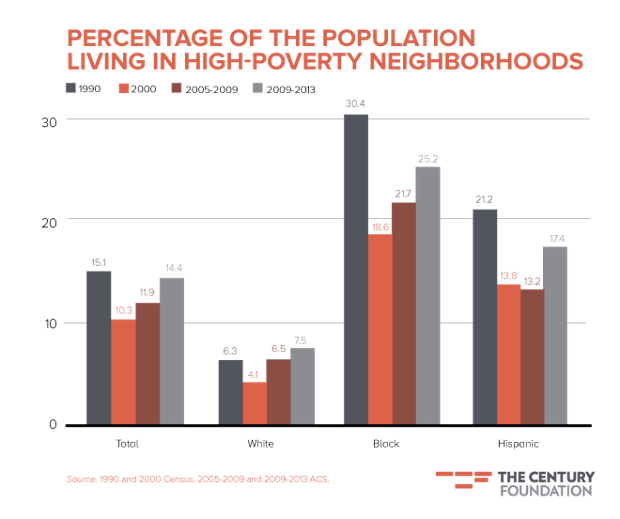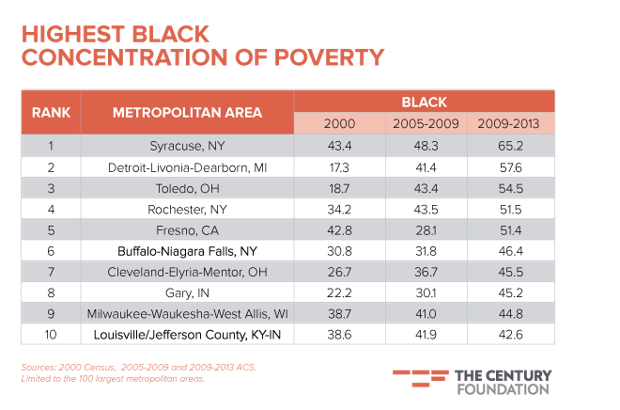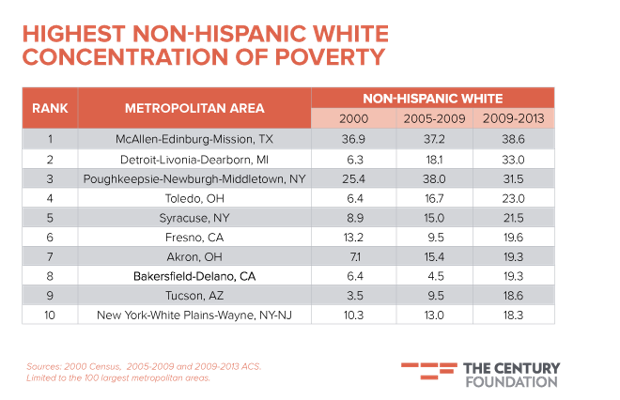Thanks to New York Mayor Bill de Blasio, economist Thomas Piketty, and, of course, the Occupy Movement, inequality is firmly on the national agenda. While income inequality has worsened considerably over the past couple of decades, America and its cities face a far deeper problem of increasing racial and economic segregation, along with concentrated poverty. Urban sociologists like Harvard’s Robert Sampson and NYU’s Patrick Sharkey have shown how concentrated neighborhood poverty shapes everything from higher crime rates to limited social mobility for the people—and especially the children—who live in these neighborhoods.
As my Atlantic colleague Alana Semuels has detailed, a new Century Foundation study from Paul Jargowsky, director of the Center for Urban Research and Urban Education at Rutgers University, reveals the devastating growth of geographically concentrated poverty and its connection to race across America. To get at this, Jargowsky used detailed data on more than 70,000 Census tracts from the American Community Survey and the decennial Census to track the change in concentrated poverty between 1990 and 2013. Concentrated poverty is defined as neighborhoods or tracts where 40 percent or more of residents fall below the federal poverty threshold (currently $24,000 for a family of four). The study looks at this change across the nation as a whole and within its major metropolitan areas.
The Statistics
The number of people living in concentrated poverty has grown staggeringly since 2000, nearly doubling from 7.2 million in 2000 to 13.8 million people by 2013—the highest figure ever recorded. This is a troubling reversal of previous trends, particularly of the previous decade of 1990 to 2000, where Jargowsky’s own research found that concentrated poverty declined.
Concentrated poverty also overlaps with race in deeply distressing ways. One in four black Americans and one in six Hispanic Americans live in high-poverty neighborhoods, compared to just one in thirteen of their white counterparts.

The table below shows the percentage of inhabitants in high-poverty neighborhoods by age, as well as race and poverty status. Jargowsky finds that poor children are even more likely to live in high-poverty neighborhoods than poor adults. Poor black children under six years of age demonstrate the widest gap in poverty concentration (28 percent). In contrast, poor white children were less likely to live in high-poverty neighborhoods than poor white adults, and saw only a 6.2 percent gap in poverty concentration.

The report delves deeply into the geography of concentrated poverty. The Midwest (or North Central region), hard hit by deindustrialization and the economic crisis, has seen by far the largest increases in concentrated poverty, as the graph below from the report shows. Jargowsky notes that concentrated poverty more than tripled in Detroit, where the number of high poverty neighborhoods or tracts grew from 51 in 2000 to 184 by 2013. Over this time, concentrated poverty spilled out of the city and into the suburbs.

The map below tracks changes in the black concentration of poverty since 2000. On the map, dark red signifies an increase of 10 percent or more in the concentration of poverty, while light grey signifies a ten percent decrease in poverty concentration. Red is splayed across a good deal of the map, indicating that concentrated poverty has grown in neighborhoods across the country.

While we think of ghettos and barrios as the province of big urban centers, concentrated poverty grew much faster in small and medium sized metros of 500,000 to a million people, as shown on the graph below. Concentrated black poverty has increased the fastest in places like Syracuse, New York; Dayton, Ohio; Gary, Indiana; and Wilmington, Delaware, while it has actually declined in larger metros like New York, Los Angeles, Atlanta, and Washington, D.C.

The graph below shows the metros with the highest levels of concentrated black poverty. These are mainly all Rustbelt metros. Syracuse, New York, tops the list, followed by the Detroit metro area; Toledo, Ohio; and Rochester, New York.

The next one shows the metros with the highest levels of Hispanic concentrated poverty. Syracuse tops this list as well, followed by Philadelphia; McAllen, Texas; and Detroit.

The last one shows the metros with the highest levels of concentration of non-Hispanic white poverty. This time, McAllen tops the list, followed by Detroit; Poughkeepsie, New York; and Toledo, Ohio.

But all three lists are troublingly similar. McAllen, Buffalo, Cleveland, Milwaukee, and Rochester are on two of the lists, while Detroit and Syracuse appear on three. Racially concentrated poverty strikes hardest at economically distressed Rustbelt metros.
Housing Reform and More
As Jargowsky sees it, the rise of concentrated poverty is the consequence of deep and fundamental changes in the spatial organization of America, and the sorting of its population across cities and suburbs. As he explains it:
“Suburbs have grown so fast that their growth was cannibalistic: it came at the expense of the central city and older suburbs. In virtually all metropolitan areas, suburban rings grew much faster than was needed to accommodate metropolitan population growth, so that the central cities and inner-ring suburbs saw massive population declines. The recent trend toward gentrification is barely a ripple compared to the massive surge to the suburbs since about 1970.”
He then adds, “Public and assisted housing units were often constructed in ways that reinforced existing spatial disparities.”
As a consequence, the geography of concentrated poverty is no longer the exclusive province of the urban core, but has spread to the suburbs as well. The geography of concentrated poverty also reflects the rise of an increasingly spiky and uneven geography of economic growth, with small and medium-sized metros in the Midwest and parts of the Sunbelt being left furthest behind.
Jargowsky notes that concentrated poverty is not inevitable, but rather the result of “choices” our society makes. To deal with it, he suggests two broad changes. On the one hand, he urges higher levels of government to implement controls over suburban development that can ensure that new housing construction is in line with the growth of a metro population. On the other, he suggests that these controls also ensure that new housing development matches the income distribution in the metropolitan area as a whole. “To some, this suggestion may seem like a massive intervention in the housing market,” Jargowsky writes. “In fact, exclusionary zoning is already a massive intervention in the housing market that impedes a more equitable distribution of affordable housing.”
In addition to these critical housing reforms, I would add three things. First, we not only need to build more housing, but to build affordable housing in increasingly unaffordable urban centers—something that is in line with Jargowsky’s suggested reforms. Second, we need to act on the income side of the affordability equation by raising the minimum wage to reflect local living costs, while working hard to upgrade the wages and working conditions of the nation’s more than 60 million poorly paid service workers. And third, we need to invest in transit to connect disadvantaged areas in both the urban center and the suburbs to areas of jobs and opportunity.
In short, concentrated poverty is deepening. Far more troubling than simple income inequality, our nation is being turned into a patchwork of concentrated advantage juxtaposed with concentrated disadvantage. The incomes and lives of generation after generation are being locked into terrifyingly divergent trajectories. Now more than ever, America is in need of new 21st century urban policy.